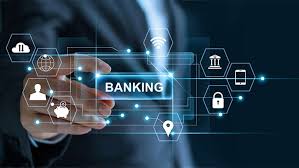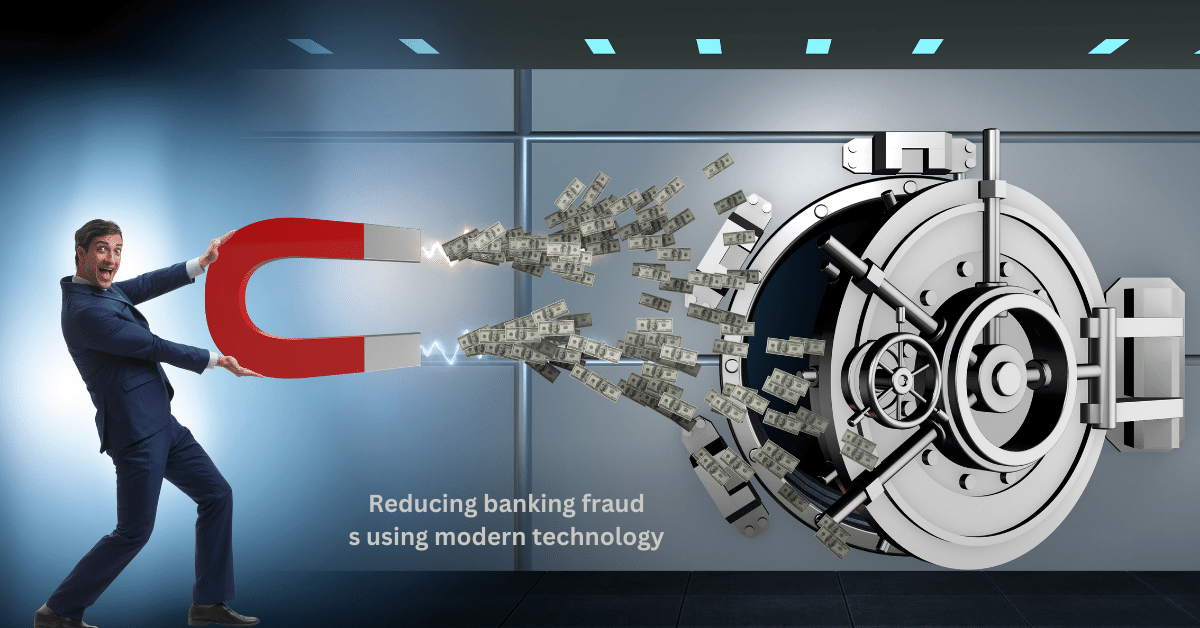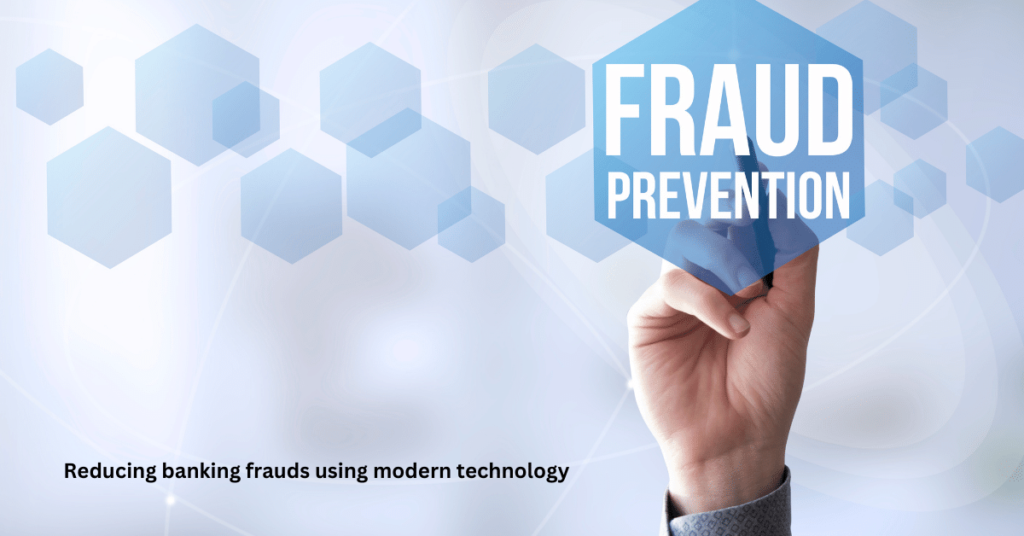In an era controlled by electronic transactions and technical developments, the specter of banking fraud looms huge. As economic landscapes advance, so do the strategies of those seeking unauthorized gains. This short article”reducing banking frauds using modern technology” explores the proactive procedures and sophisticated technologies utilized by banks to deal with scams successfully. From traditional scams to the obstacles faced by electronic banks, we decipher the ins and outs of financial scams avoidance. Join us on a trip with the function of modern innovation in securing financial institutions, supplying understandings that are both relevant and important in the ongoing fight versus deceptive tasks. Stay tuned to find the methods, tips, and arising fads that equip financial institutions and clients alike in the battle versus monetary deception.
 Reducing Banking Frauds using Modern Technology
Reducing Banking Frauds using Modern Technology
Usual Banking Frauds
As the financial landscape evolves, so do the methods employed by fraudsters. Understanding the common banking scams is important for both financial institutions and clients to stay one action ahead of prospective dangers.
Traditional Frauds
Charge Card Frauds:
Credit card fraud continues to be a consistent difficulty for banks and customers alike.
Tactics: Unauthorized deals, stolen card details, and identity theft.
Prevention: Implementation of multi-factor authentication and real-time deal tracking.
Account Hacks:
Unauthorized accessibility to savings account presents a substantial threat.
Tactics: Phishing strikes, weak passwords, and social engineering.
Prevention: Encouraging strong password methods, enlightening customers on phishing threats, and using sophisticated safety procedures.
 Digital Banking Frauds
Digital Banking Frauds
Prone Aspects:
The increase of electronic banks presents brand-new vulnerabilities.
Aspects at Risk:
Customer Onboarding: Lack of durable identity verification throughout onboarding.
Credit Card Fraud: Increased sensitivity in the digital realm.
Account Protection: Potential weak points in protecting client accounts.
Trick Problems for Digital Banks:
Lack of Historical Data: Limited historic data hampers efficient fraud evaluation.
New Banking Products, New Fraud Threats: Introduction of innovative financial products brings new avenues for scams.
Different KYC Processes: Inconsistencies in Know Your Customer procedures create loopholes.
Digital Banks Scale Quickly: Rapid growth might outmatch the application of robust protection actions.
Comprehending these typical financial fraudulences lays the structure for the succeeding sections, where we explore the duty of technology in alleviating these risks and strengthening the safety of economic systems. The electronic age demands a proactive strategy to guarding monetary properties, and by analyzing these conventional and electronic risks, we can much better value the requirement of progressing fraudulence prevention methods.
 Technologies in Combatting Banking Frauds
Technologies in Combatting Banking Frauds
The fight versus banking scams has intensified with the combination of innovative technologies. In this section, we explore the role of technology in both standard and electronic financial spheres.
Digital Banking Fraud Detection
Function of Technology:
Modern innovation functions as a powerful ally in discovering and avoiding electronic financial fraudulence.
Advanced Analytics: Utilizing advanced analytics to determine uncommon patterns and prospective hazards.
Machine Learning Models: Deploying machine learning formulas for real-time fraudulence discovery.
Trick Challenges and Trends in 2023:
Enhanced Social Engineering: Fraudsters increasingly employ innovative social engineering strategies.
Fraud-as-a-Service: The appearance of fraud-as-a-service platforms complicates scams detection.
Biometrics Fraud: Biometric data susceptabilities present brand-new challenges.
Synthetic IDs: Creation of artificial identities for fraudulent tasks gets on the surge.
IDcentral’s Digital Onboarding Solution: Exploring innovative identity confirmation options.
 Fraud Prevention Methods for Traditional Banking
Fraud Prevention Methods for Traditional Banking
Multi-Factor Authentication:
Strengthening security with multi-layered authentication procedures.
Biometric Verification: Utilizing finger prints, facial recognition, or iris scans.
One-Time Passwords (OTPs): Adding an extra layer via vibrant passcodes.
Transaction Monitoring:
Real-time monitoring to spot and obstruct suspicious deals.
Behavioral Analysis: Analyzing purchase patterns to determine abnormalities.
Automated Alerts: Notifying consumers and institutions of potentially deceitful activities.Welcoming technology in the battle versus fraud extends past digital financial, infiltrating standard financial systems to reinforce safety actions. The integration of advanced analytics, machine learning, and biometric verification not only finds however additionally anticipates potential dangers.
As we browse the landscape of fraudulence discovery technologies, we get understandings into the progressing strategies that financial institutions employ to stay in advance in this continuous battle. In the next areas, we explore certain strategies for typical and digital financial institutions, highlighting the effectiveness and efficiency of these technical treatments.
Methods for Digital Banks
In the realm of digital banking, where ease satisfies susceptability, the application of reliable techniques is extremely important. This area explores just how digital banks can leverage technology to strengthen their defenses against scams.
Implementing Anti-Fraud Tools
Danger Sensitivity:
Understanding the risk landscape and tailoring safety actions appropriately.
Real-Time Risk Assessment: Continuously assessing threats based upon deal data.
Adaptive Security Protocols: Adjusting protection measures based on the regarded hazard degree.
Private Customer Focus:
Recognizing the one-of-a-kind electronic footprint of each client.
Behavioral Biometrics: Analyzing individual habits patterns for verification.
Personalized Security Settings: Empowering consumers to tailor their safety choices.
Leveraging Technology for Efficiency
360-degree Monitoring:
Comprehensive surveillance of all electronic banking activities.
Device Fingerprinting: Identifying and tracking gadgets used for banking transactions.
User Behavior Analytics: Understanding typical individual actions to spot deviations.
Automation with Machine Learning:
Harnessing the power of artificial intelligence for computerized fraudulence discovery.
Pattern Recognition: Teaching formulas to acknowledge progressing scams patterns.
Alert Automation: Instantaneous generation of alerts for dubious activities.
Digital banks encounter one-of-a-kind difficulties, consisting of quick scaling and a vibrant threat landscape. By taking on risk-sensitive approaches and focusing on individual consumer subtleties, these financial institutions can reinforce their defenses. The integration of 360-degree tracking and machine learning not only enhances performance however additionally guarantees an aggressive action to arising hazards. As we navigate with the electronic financial techniques, the limelight stays on leveraging modern technology not equally as a defense mechanism yet as a calculated advantage in the ever-evolving landscape of scams prevention.
 Present Scenario and Future Challenges
Present Scenario and Future Challenges
As modern technology becomes an integral part of combating financial scams, it’s important to assess the present situation and prepare for future challenges. This area discovers the experiences of creating nations, incorporating modern technology to battle bank fraud and the obstacles existing ahead.
Integrating Technology to Combat Bank Frauds
Obstacle of Mitigating Bank Frauds:
Developing countries face one-of-a-kind difficulties in mitigating financial institution fraudulence.
Limited Resources: Constraints in spending plan and infrastructure hinder robust fraudulence prevention steps.
Adopting Technology Solutions: The important need to incorporate modern technology for affordable remedies.
Experience of a Developing Country:
Real-world experiences of integrating modern technology to deal with financial institution scams.
Success Stories: Instances where technology successfully obstructed deceitful activities.
Lessons Learned: Extracting beneficial understandings from both successes and failings.
 Future Prospects:
Future Prospects:
The Fight Against Bank Frauds: Current Scenario and Future Challenges:
Assessing the present state of the fight versus financial institution fraud.
Technological Advancements: Anticipating the role of emerging innovations in future scams prevention.
Collaborative Efforts: The necessity of global partnership to stay ahead of cross-border fraud.
Difficulties of Mitigating Bank Frauds by Judicious Mix of Technology:
Balancing technology with other safety nets.
Human Element: Recognizing the significance of human caution alongside technological services.
Regulatory Frameworks: The need for robust regulative structures to direct technical implementations.Understanding the difficulties encountered by establishing nations sheds light on the global resist financial institution fraudulence.
The experiences of integrating modern technology offer useful understandings for other nations. Looking ahead, the short article delves into the future prospects of the battle against financial institution fraud, stressing the constant advancement of technology and the joint initiatives needed to take on the ever-changing landscape of fraudulent activities.
 Tips for Reducing Banking Fraud
Tips for Reducing Banking Fraud
In the ruthless fight versus banking scams, positive measures play a pivotal role. This area offers functional suggestions for both banks and clients to minimize the threat of coming down with deceptive activities.
Multi-Factor Authentication:
Multi-factor authentication (MFA) adds layers of safety and security past typical passwords.Incorporates something the customer knows (password), has (safety token), and is (biometric data).
Transaction Monitoring:
Real-time tracking of deals helps determine and halt dubious tasks.Automated systems assess deal patterns and cause notifies for uncommon actions.
Corporate Account Reconciliation:
Businesses must resolve company accounts day-to-day to detect unapproved purchases without delay.Regular settlement guarantees inconsistencies are dealt with before they escalate.
Dual and Triple Controls:
Implementing dual and three-way controls adds layers of approval for vital purchases.Reduces the danger of unapproved gain access to and transactions.
Fraud Awareness Campaigns:
Educating clients and staff members concerning potential fraud risks.Promoting recognition regarding typical fraud techniques and safety nets.Implementing these suggestions creates a durable protection versus banking fraud. Multi-factor verification gives a strong barrier versus unauthorized access,
while transaction tracking makes sure quick actions to questionable activities. Company account settlement and dual/triple controls include an extra layer of security for companies, lessening the effect of potential scams. Finally, promoting fraud understanding guarantees that people remain alert and contribute to the cumulative effort to lower banking scams. By complying with these tips, banks and customers can collectively contribute to developing a safer financial atmosphere.
 Reliable Fraud Solutions for Banks
Reliable Fraud Solutions for Banks
In the vibrant landscape of financial, effective fraudulence remedies are crucial to secure both banks and their customers. This section discovers particular techniques and technical options that prove critical in mitigating scams risks.
Monitoring Transactions:
Real-time tracking of purchases serves as a frontline defense against fraud.Automated systems examine purchase patterns, swiftly identifying abnormalities.
Check Internal Threats:
Internal risks, often forgot, present a significant danger to banks.Implementing internal tracking systems to spot uncommon worker tasks.
Educate Customers:
Customer education and learning is an effective device in scams prevention.Banks need to supply resources to educate clients concerning typical fraudulence techniques and exactly how to prevent them.
Use Real-Time Data:
Utilizing real-time data enhances scams detection capabilities.Immediate evaluation of data streams enables speedy identification of suspicious tasks.
Deploy Machine Learning:
Machine discovering algorithms supply flexible and predictive capabilities.Continuous knowing allows systems to progress and adjust to new fraudulence patterns.
 Scams Management System in Banking with Tech
Scams Management System in Banking with Tech
Biometrics Integration:
Biometric verification adds a layer of safety past typical approaches.Fingerprint, facial acknowledgment, and iris scans provide distinct and secure identifiers.
Artificial Intelligence Implementation:
Artificial intelligence improves scams detection by examining substantial datasets.Predictive analytics and pattern acknowledgment contribute to positive fraudulence avoidance.
Data Integration for Fraud Prevention:
Integrating information from various sources develops a comprehensive fraud prevention system.Cross-referencing info enhances precision and lowers incorrect positives.Carrying out these reliable fraudulence remedies empowers financial institutions to stay ahead of evolving threats.
From real-time transaction keeping track of to the assimilation of sophisticated technologies like biometrics and artificial intelligence, each method adds to a durable protection versus scams. By integrating these options right into a comprehensive fraud management system, banks can produce an aggressive and adaptive technique to securing monetary transactions and guaranteeing the depend on and protection of their customers.
 Fraud Management System in Banking with Tech
Fraud Management System in Banking with Tech
Scams management systems fortified by innovative technologies form the backbone of a secure financial setting. This area unravels the assimilation of modern technology, specifically biometrics, expert system, and information combination, in creating a comprehensive fraud management system for banks.
Biometrics Integration:
Biometric authentication presents a very secure and personalized layer to scams avoidance.Fingerprint scans, face recognition, and iris scans give one-of-a-kind organic identifiers.Significantly minimizes the danger of unauthorized accessibility, as biometric data is challenging to replicate.
Application Benefits:
Enhanced User Authentication: Biometrics use a more reliable ways of validating individual identity.
Streamlined User Experience: Biometric methods streamline authentication without the demand for typical passwords.
Prevention of Identity Theft: The originality of biometric information prevents deceptive attempts to impersonate people.
Artificial Intelligence Implementation:
Artificial intelligence (AI) transforms fraudulence detection by refining vast datasets.Predictive analytics and pattern acknowledgment equip systems to proactively recognize potential risks.Continuous discovering makes it possible for AI to adjust to emerging scams patterns, staying one step ahead of scammers.
Application Benefits:
Proactive Threat Detection: AI algorithms analyze historic and real-time information to recognize abnormalities.Adaptive Strategies: Machine knowing permits systems to develop and adapt to new fraud tactics.Reduced False Positives: AI’s nuanced understanding decreases the event of false alarms, improving the precision of fraudulence discovery.
Data Integration for Fraud Prevention:
Integrating information from varied resources creates a holistic sight of consumer behavior and deals.Cross-referencing details from internal and outside resources improves the precision of fraud detection.Real-time information integration allows for immediate actions to possible threats.
Execution Benefits:
Comprehensive Risk Assessment: Combining numerous information resources supplies a thorough understanding of potential threats.
Timely Response: Real-time data integration makes it possible for quick reactions to emerging dangers.
Improved Decision-Making: A holistic view of information improves the ability to make educated choices in fraudulence prevention techniques.
Finally, the assimilation of biometrics, artificial intelligence, and information combination creates a powerful defense against banking fraud. The fusion of these technologies not just strengthens the security of monetary purchases but also makes sure a smooth and effective experience for individuals. As technology remains to development, the fraud management systems in banking develop, remaining resistant versus the ever-changing landscape of deceptive activities.
 essential insights
essential insights
As we traverse the ins and outs of financial fraud avoidance, it becomes evident that the amalgamation of innovation and strategic procedures is crucial for safeguarding financial systems. This wrapping up section sums up the key insights got throughout the post and stresses the continuous commitment needed to battle developing fraudulence threats.
Summarizing the Role of Technology:
Technology stands as the linchpin in the battle versus financial fraud.From real-time transaction keeping track of to sophisticated biometrics, each technical facet adds to a comprehensive defense reaction.
Impactful Strategies:
Multi-factor verification, transaction tracking, and client education emerge as impactful methods in reducing scams.Digital banks, especially, take advantage of risk-sensitive strategies and individualized customer-focused measures.
Future Trends in Banking Fraud Prevention:
Technical Evolution:
Anticipating the constant development of technology in scams prevention.
The integration of emerging modern technologies like blockchain and progressed expert system is expected to shape future methods.
Global Collaboration:
Recognizing the value of collective initiatives on a global range.Sharing insights and technological advancements to remain ahead of cross-border fraudulence risks.
Call to Action for Banks and Customers:
Acknowledging the shared responsibility of financial institutions and consumers in fraud avoidance.Encouraging banks to stay proactive in taking on the most recent innovations and techniques.
Empowering Customers:
The duty of client awareness and vigilance in mitigating fraudulence threats.Encouraging consumers to remain informed, embrace protected practices, and record suspicious tasks immediately.
Final thought,
the fight against financial scams is a dynamic and joint effort. While modern technology develops the foundation, it is the calculated execution and ongoing adjustment to arising trends that guarantee success. As we look toward the future, an unified front, driven by technological advancement and cumulative awareness, will be important in securing the monetary landscapes we browse. By remaining watchful, educated, and versatile, both financial institutions and clients contribute to a durable protection versus the ever-evolving challenges of banking fraud.
In the relentless quest of safe financial landscapes, this post”reducing banking frauds using modern technology” has brightened the critical function of technology in combating financial scams. From the standard dangers dealt with by financial institutions to the vulnerabilities of digital financial, the integration of innovative innovations such as biometrics and expert system has actually emerged as a beacon of defense. Multi-faceted techniques, including deal surveillance and customer education and learning, strengthen the fortifications against evolving scams patterns.
As we stand at the precipice of the future, anticipating the continued advancement of innovation and the necessary of global partnership, an unified phone call to action mirrors. Banks need to continue to be aggressive in taking on the most up to date technologies, while consumers play an essential role through awareness and vigilance. In this continuous battle versus banking scams, it is the synergy of technology, strategy, and collective initiative that guarantees a resistant defense– protecting the depend on and safety inherent in financial purchases.



